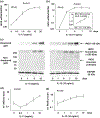IL-13 induced increases in nitrite levels are primarily driven by increases in inducible nitric oxide synthase as compared with effects on arginases in human primary bronchial epithelial cells
- PMID: 18384429
- PMCID: PMC11934259
- DOI: 10.1111/j.1365-2222.2008.02969.x
IL-13 induced increases in nitrite levels are primarily driven by increases in inducible nitric oxide synthase as compared with effects on arginases in human primary bronchial epithelial cells
Erratum in
- Clin Exp Allergy. 2008 Aug;38(8):1409. Mustovitch, A T [corrected to Mustovich, A T]
Abstract
Background: Exhaled nitric oxide is increased in asthma, but the mechanisms controlling its production, including the effects of T-helper type 2 (Th2) cytokines, are poorly understood. In mouse and submerged human epithelial cells, Th2 cytokines inhibit expression of inducible nitric oxide synthase (iNOS). Arginases have been proposed to contribute to asthma pathogenesis by limiting the arginine substrate available to NOS enzymes, but expression of any of these enzymes has not been extensively studied in primary human cells.
Objectives: We hypothesized that primary human airway epithelial cells in air-liquid interface (ALI) culture would increase iNOS expression and activity in response to IL-13, while decreasing arginase expression.
Methods: iNOS and arginase mRNA (real-time PCR) and protein expression (Western blot and immunofluorescence) as well as iNOS activity (nitrite levels) were measured in ALI epithelial cells cultured from bronchial brushings of normal and asthmatic subjects following IL-13 stimulation.
Results: IL-13 up-regulated iNOS mRNA primarily at a transcriptional level in epithelial cells. iNOS protein and activity also increased, arginase1 protein expression decreased while arginase 2 expression did not change. The changes in iNOS protein correlated strongly with changes in nitrites, and inclusion of arginase (1 or 2) did not substantially change the relationship. Interestingly, iNOS mRNA and protein were not correlated.
Conclusions: These results contrast with many previous results to confirm that Th2 stimuli enhance iNOS expression and activity. While arginase 1 protein decreases in response to IL-13, neither arginase appears to substantially impact nitrite levels in this system.
Figures







References
-
- Hamid Q, Springall DR, Riveros-Moreno V et al. Induction of nitric oxide synthase in asthma. Lancet 1993; 342:1510–3. - PubMed
-
- Howarth PH, Redington AE, Springall DR et al. Epithelially derived endothelin and nitric oxide in asthma. Int Arch Allergy Immunol 1995; 107:228–30. - PubMed
-
- Smith AD, Cowan JO, Brassett KP, Herbison GP, Taylor DR. Use of exhaled nitric oxide measurements to guide treatment in chronic asthma. N Engl J Med 2005; 352:2163–73. - PubMed
-
- Smith AD, Cowan JO, Filsell S et al. Diagnosing asthma: comparisons between exhaled nitric oxide measurements and conventional tests. Am J Respir Crit Care Med 2004; 169:473–8. - PubMed
Publication types
MeSH terms
Substances
Grants and funding
LinkOut - more resources
Full Text Sources
Other Literature Sources
Medical
Research Materials

